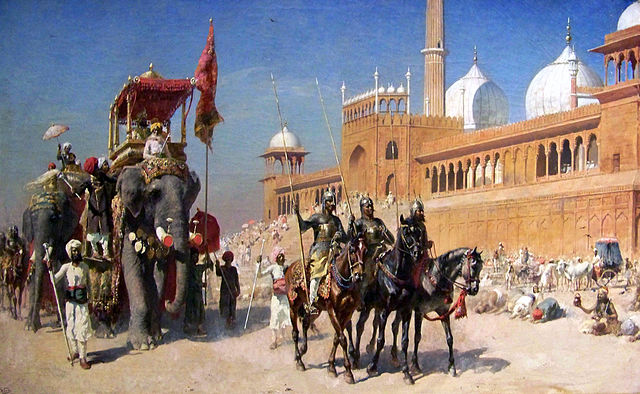Jaziya and Communal History:

01. JAZIYA
Perhaps one of the most hated, and also the most misinterpreted word, taught in history books is – Jaziya.
Jaziya was a form of ‘protection tax’ tax collected from non-Muslims residing in place where Islamic law was practiced.
In Islam, 4 types of taxes were permissible, which can be collected from the subject classes.
- Zakaat: tax payable by Muslims (2.5% of their total wealth, which included land, ornaments, cash etc.) which was collected annually by the state.
- Jaziya: protection tax collected from non-Muslims. The rate is nowhere mentioned, and most historians opine that it was occasionally collected, and a number of classes/groups were exempted from paying it.
- Khams: war booty. Of this 1/5th (Khams) went to the state and 4/5th (Ghanima) was to be distributed among soldiers.
- Kharaj: land tax (lagan). Land tax payable by Muslims was known as ‘Ushr’. The rate was different for Kharaj and Ushr, with Ushr being lower. This was done to promote conversions since the Sultanate rulers needed the subject class which belonged to their faith so that they can establish a foothold here. But when the Sultanate was firmly established, the rate of Ushr and Kharaj became same.
Now, if Hindus paid Jaziya and Muslims paid Zakaat, why is Jaziya such a hated term in history???
The state is concerned with taxes. If you impose only Jaziya and not Zakaat, then there would be an incentive for conversion and more Hindus would become Muslims (so as to avoid paying Jaziya). But what benefit would this conversion accrue to the ruling class if they don’t collect Zakaat?
Similarly, if you collect only Zakaat and not Jaziya, reverse conversion (Ghar Waapsi) would take place, since Muslims would turn Hindu to avoid paying Zakaat, and the state would suffer the loss of revenue. That’s how economics, religion, and politics worked. To get a working situation, we need to have equilibrium, and for that Zakaat as well as Jaziya need to be imposed with varying degree keeping in mind the socio-economic dynamics of the time. ??
02. COMMUNAL HISTORY:
Jaziya was implemented by some Sultans and some Mughal rulers, without a mention of the rate or amount. What we know from history books is that there were many classes/groups among non-Muslims who were exempted from paying it, such as women, children, elders, handicapped, ill, insane, hermits, monks, slaves and those non-Muslims who were temporarily residing in Muslim lands. The Brahmins were exempted from paying it, since the Sultans considered it politically expedient not to affront the religious and learned elites among the Hindus. The first bigot ruler we come to ‘know’ in Sultanate times was Firoz Tughluq, who implemented Jaziya on Brahmins in 1376. But Jaziya was imposed on other classes before Firoze. That implies historians didn’t consider rulers before Firoze Tughluq as bigots since they didn’t impose Jaziya on Brahmins. That’s what happens when you impose Jaziya upon the learned elite- they would label you as a bigot in history ??
Similarly, the most bigoted ruler among the Mughals we get to ‘know’ was Aurangzeb. He re-imposed Jaziya upon Hindus in 1679, which was removed earlier by Akbar in 1564. But what the ‘learned’ historians conveniently omitted from books was that Aurangzeb withdrew Jaziya 2 years later in 1681, upon the request of Jai Singh.?? The said bigoted Mughal emperor, Aurangzeb also had the largest number of Hindu nobility in his durbar among all the Mughal rulers. When Aurangzeb came to power, he removed 80 taxes (which were called ‘Abwabs’ and which did not find mention in Islamic Law books). That implies that 84 taxes (there are only four taxes valid in Islam- Zakat, Kharaj, Jaziya and Khams) were in place prior to Aurangzeb. Sorry, but that’s how Taj Mahal was built- from the money of ‘aam aadmi’. ??
But Shah Jahan’s era is regarded as Golden era, isn’t it? When you pay your durbaris (which included historians) in gold, they would obviously sing paeans for you. That also implies that Arnab Goswamis (okay, Sudhir Chaudharies, Rajat Sharmas, Shweta Singhs etc etc as well??) were always there in durbar. It’s only the patron who changed. When Aurangzeb came to power, he removed the singers, musicians, painters, historians etc from the durbar, which he considered to be drain on the central treasury. Now if Arnab Goswami becomes jobless, he would obviously heap abuses upon the person responsible for his miserable position and paint him as a bigot. That’s how historians labeled Aurangzeb as a bigoted ruler.??
Aurangzeb was not a saint either. He was responsible for the decay of the empire, as well as for the economic distress which the empire faced during the later half of his reign due to his ill-conceived expansionist policies. History ought to be taught objectively and people ought to know about the forces which rule from behind. It is true that pen is mightier than a sword. But the one who pays for the ink is the mightiest.
??
The post was first published by Farhan Rahman on his Facebook Timeline.

